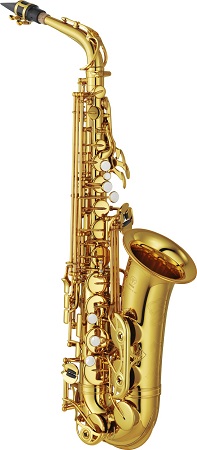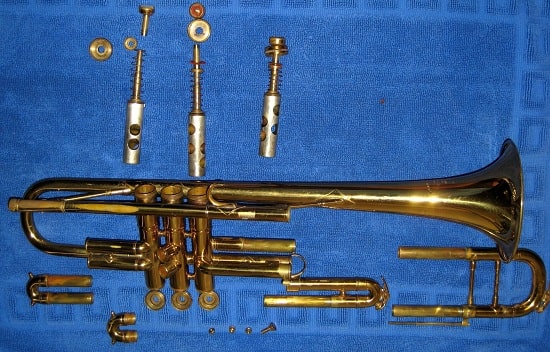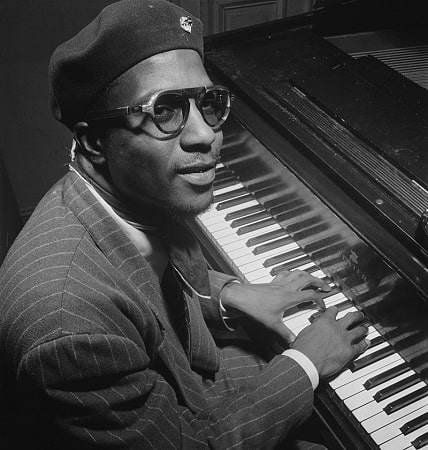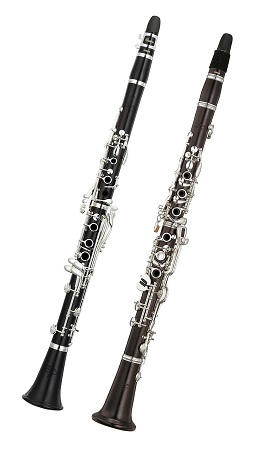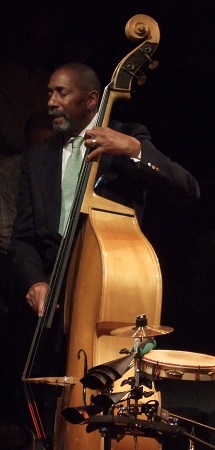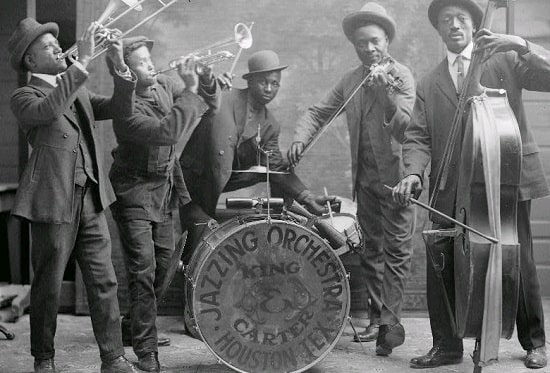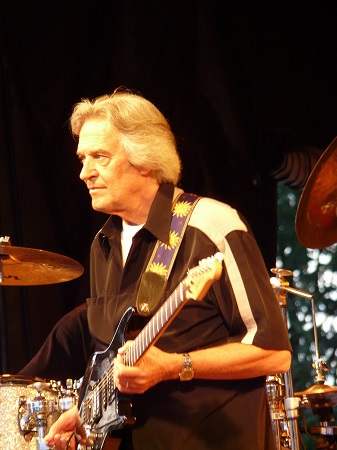Jazz music uses a specific set of instruments recognized for creating that unique jazz-style feel. It is recognized for its distinct sound and style.
As jazz is so versatile and spontaneous, it is a form that is often highly exploratory in terms of instrumentation.
This indicates that much modern jazz attempts to vary its musical selections; nonetheless, a few instruments appear in most jazz bands.
This article lists a few of the most popular jazz instruments in detail.
Warren “Baby” Dodds started working in marching bands in New Orleans in the early 1900s and is considered one of the first great jazz drummers.
The following are among the most popular lineups.
Typical Jazz Band: The rhythm section (Drum, Bass, and Keyboard or Guitar), Clarinet, Trumpet, Trombone.
Swing Band: Rhythm section, Saxophones, Trombone, Trumpets
Jazz Trio: Piano, Drums, Bass.
Vocalists often use scat singing to improvise and imitate instrumental sounds.
Today, the clarinet is less prevalent in jazz, but it gives special attention due to its warm, rounded tone.
Like the tenor saxophone, the alto saxophone is one of the most regularly played saxophones.
This saxophone is broadly applied in all genres of music, such as classical, jazz, and rock. Charlie Parker and Jimmy Dorsey are two well-known alto saxophone players.
Saxophone
The saxophone is a single-reed woodwind brass instrument with a conical shape. When a reed on a mouthpiece vibrates, it creates sound waves inside the instrument’s frame.
The pitch is regulated by changing the adequate size by enclosing holes in the body. The saxophone has become the most recognizable jazz instrument, adapting to various genres.
Its tone has become synonymous with jazz music, from Coleman Hawkins and Lester Young through contemporary pioneers like Charlie Parker and John Coltrane to modern-day saxophonists such as Chris Potter, Mark Turner, and Joshua Redman.
The saxophone developed as a jazz instrument after widespread use in dance bands in the early 1920s. The Fletcher Henderson Orchestra, founded in 1923, used saxophone arrangements to support improvisation.
Following in the footsteps of the Fletcher Henderson Orchestra, the Duke Ellington Orchestra and Jean Goldkette’s Victor Recording Orchestra included jazz solos on saxophones and other instruments.
Later saxophone techniques that pervaded Bebop, rhythm, and blues in the early postwar era were affected by the swing era.
Coleman Hawkins promoted the tenor saxophone as a jazz solo instrument while working with Fletcher Henderson from 1923 through 1934.
Before Lester Young, Hawkins’ arpeggiated, rich-toned, vibrato-laden approach was the dominant influence on swing-era tenor musicians.
Swing-era alto styles were influenced by Benny Carter and Duke Ellington’s alto saxophonist Johnny Hodges. Harry Carney popularized the baritone saxophone in the same period with the Duke Ellington Orchestra.
Lester Young’s technique differed from Hawkins’s tenor saxophone, focusing on more melodic “linear” playing that flowed in and out of the harmonic framework and longer phrases that varied from those suggested by the composition.
Lester Young’s presence with the Count Basie Orchestra in the late 1930s and the popularity of Hawkins’ 1939 performance of “Body and Soul” established the saxophone as a jazz influence on a level with the trumpet.
However, the saxophone’s most significant influence on jazz came later, when alto saxophonist Charlie Parker became an icon of the bebop revolution, which affected generations of jazz performers.
In modern jazz, Steve Lacy reintroduced the soprano saxophone, and John Coltrane expanded its prominence in the 1960s. Kenny G plays the soprano sax as his primary instrument a smooth jazz artist.
With the avant-garde trend of the 1960s, saxophonists such as John Coltrane, Ornette Coleman, Sam Rivers, and Pharoah Sanders marked the forefront of creative experimentation.
Trumpet
The trumpet is a wind instrument often seen in classical and jazz ensembles. They are played by blowing air through the embouchure, which creates a “buzzing” sound in the resonator inside the instrument.
The trumpet was the principal instrument in early jazz, and it played an important role. Borrowing from marching band orchestration, it was popular in bands from the 1890s to the 1930s, eventually gaining popularity during the big band and swing eras.
Buddy Bolden, an early trumpet pioneer, was most likely the first known jazzman merely because he was a trumpeter, which persisted with Freddie Keppard and Louis Armstrong.
In particular, Louis Armstrong and Miles Davis are often regarded as two of the twentieth century’s most influential artists. Their abilities and the subsequent impact on music were extensive.
They were both highly regarded trumpet virtuosos who redefined composer roles and created essential Jazz styles.
Louis Armstrong was famous for his virtuosity and solos on the Hot Five and Hot Seven albums. His transition from cornet to trumpet is widely seen as marking the trumpet’s triumph over the cornet in jazz.
Miles Davis is primarily viewed as the most influential musician of the twentieth century, owing to his distinct and frequently imitated style. Davis’ solo articulation and sense of space have served as templates for decades of jazz performers.
Another notable trumpeter who has assumed a leading role, Wynton Marsalis, has dedicated his career to being an effective instructor and presenting the music to classical and jazz global audiences.
Dizzy Gillespie was a brilliant improviser with a wide range built on Roy Eldridge’s technique while developing extra layers of harmonic intricacy.
Gillespie significantly influenced practically every trumpeter, both through his performance and as a mentor to newer performers.
Cat Anderson was a trumpeter who performed with Duke Ellington’s Big Band and played exceptionally high with even more extreme volume.
Maynard Ferguson rose to popularity as a member of Stan Kenton’s ensemble before launching his band in 1957. He was known for playing consistently in a relatively high register.
Detroiter Donald Byrd, Clark Terry, Clifford Brown, Freddie Hubbard, Bix Beiderbecke, Chet Baker, Pontiac’s Thad Jones, Lee Morgan, and others are notable trumpeters.
Piano
The piano is an acoustic stringed keyboard with wooden hammers covered with a softer coating that hits the strings. It is played on a keyboard, consisting of a row of keys that the player presses or strikes with their fingers to force the hammers to hit the string.
Jazz piano refers to a pianist’s technique when performing jazz. Since its beginnings, the piano has been a fundamental component of the jazz genre in solo and group settings. Its varied role is mainly due to its harmonic and melodic capabilities.
During the 1920s, a new style is known as “stride” or “Harlem stride” evolved, primarily in New York; James P. Johnson was a prominent follower. The left hand set the rhythm, while the right-hand improvised songs.
Since the early days of jazz piano, improvisation has evolved. Many performers improvised “by ear,” enriching the melody with embellishments and moving notes during the Swing era.
However, the bebop era’s quick tempo and intricate chord progressions made it increasingly difficult to perform “by ear.” Bebop-era jazz pianists experimented with chord changes alongside other improvisers.
Playing the piano evolved from a primary timekeeper to a more versatile role over time. Finally, the accomplished pianist was free to lead and respond to the instrumental soloist, employing fast and prolonged chordal and melodic fragments—a style known as comping. In the early days, not most renowned pianists provided comping.
Notably, Duke Ellington, who rose to prominence in the Cotton Club during the Harlem Renaissance, was a highly regarded musician. Ellington competed enthusiastically in support of the soloist and helped develop the technique.
Several outstanding pianists appeared in the 1940s and 1950s. Pianists such as Thelonious Monk and Bud Powell were instrumental in developing and popularizing the bebop sound.
Bill Evans developed Bud Powell’s style while adding a unique classical flavor. Simultaneously, Oscar Peterson emphasized rhythmic changes and influenced Art Tatum, Teddy Wilson, and Nat King Cole’s styles.
Miles Davis’s pianists included Wynton Kelly, Red Garland, Herbie Hancock, and Keith Jarrett. Tommy Flanagan was featured on John Coltrane’s blockbuster album Giant Steps. McCoy Tyner, who played alongside John Coltrane, is another significant performer.
Clarinet
Clarinets are woodwind instruments with a single-reeded mouthpiece, a straight, cylindrical tube with a nearly cylindrical body, and a flared bell. The cylindrical body is the primary cause of the clarinet’s characteristic timbre.
Clarinets have the most comprehensive pitch range of any conventional woodwind instrument. The most popular instrument was the B soprano.
Nonetheless, several early jazz players used the C soprano, and several New Orleans jazz brass ensembles utilized the E soprano.
Initially, with the New Orleans performers in the 1910s, the clarinet was a powerful instrument in jazz. Throughout the significant big-band period through the 1940s, it remained a distinctive jazz instrument.
Many New Orleans jazz pioneers, such as Johnny Dodds, Jimmie Noone, and Sidney Bechet, released some of the first jazz clarinet recordings, which helped disseminate jazz across the country.
Working with jazz icons such as Kid Ory, King Oliver, and Louis Armstrong, these clarinetists helped define the sound of jazz.
As swing took over the American musical landscape, big bands fronted by clarinetists such as Benny Goodman and Artie Shaw rose to prominence. With the decline in popularity of big bands in the 1940s, the clarinet lost its central position in jazz.
By that time, popularity in Dixieland or authentic New Orleans jazz had reappeared; Pete Fountain was one of the genre’s most well-known musicians.
Bob Wilber, engaged since the 1950s, is a more varied jazz clarinetist who plays in various classic jazz styles.
The clarinet’s role in the jazz ensemble has been taken over by the saxophone, which has a bigger sound and a more straightforward fingering system.
The clarinet, however, did not wholly disappear from jazz. Since the 1950s, notable players have included Stan Hasselgrd, Buddy DeFranco, Jimmy Giuffre, Eric Dolphy, Perry Robinson, and John Carter.
Double Bass
The lowest-pitched stringed instrument is the double bass. It is played using a bow or by plucking the strings. Jazz bassists improvise accompaniment basslines and solos in a jazz style on the double bass or electric bass guitar.
The double bass was first used in jazz in the 1890s to provide the low-pitched strolling basslines that characterized the chord developments of the songs.
The deep, woody sound of the double bass grounded everything from small jazz combinations to massive jazz big bands from the swing and substantial band eras, through Bebop and Hard Bop, to the “free jazz” movement.
Starting around 1890, the African communities of early New Orleans had a jazz ensemble that performed a mash-up of marching, ragtime, and Dixieland music.
The music evolved from performing for funerals on the street to bars and brothels, with the double bass eventually replacing low-pitched wind instruments. Many early bassists played both the brass and string basses.
As an unamplified double bass is usually the quietest instrument in a jazz ensemble, many 1920s and 1930s adopted the slap technique, slapping and pulling the strings to create a percussive slapping effect against the fretboard.
The slap style breaks through a band’s sound better than simply picking the strings and allowing the bass to be heard more clearly on early sound recordings.
Jimmy Blanton, who played alongside Duke Ellington during the Swing era, and Oscar Pettiford, who popularized the instrument’s soloistic use in Bebop, are two double bass musicians who have contributed to the emergence of jazz.
Charles Mingus, who pioneered hard bop, and Charlie Haden, primarily recognized for his collaboration with Ornette Coleman, influenced free jazz.
Some notable bandleaders began to request that their bass players adopt the bass guitar in the 1950s. Besides jazz fusion and Latin-influenced jazz, the double bass remained popular in jazz in the 2010s.
A plucked double bass’s deep timbre and woody tone differ from a fretted bass guitar.
Drums
A drum kit is a bunch of drums, cymbals, and other percussion instruments arranged on stands to be struck by a player, using drumsticks and the feet controlling pedals that control the hi-hat cymbal, the bass drum beater.
Jazz drumming spans from Dixieland jazz in the 1910s to jazz-fusion in the 1970s and Latin jazz in the 1980s.
Jazz drumming evolved alongside the music during the twentieth century since each phase in the growth of jazz—for example, swing and Bebop—had its rhythmic approach.
The continuous “freeing” of the rhythm was one trend that occurred over time. However, older styles endured throughout later periods.
The boundaries between these periods are hazy, partly because no single style superseded others; there are several cross-influences between styles. African music and jazz share several key characteristics, most notably the role of improvisation.
Other includes using instruments to imitate the human voice, the superimposition of one rhythmic structure onto another, and repeating rhythms used across a musical piece, often referred to as clave rhythms.
Percussionists and their rhythms functioned as accompaniments for dance bands that played ragtime and numerous dances from the 1900s through the 1940s, with jazz arriving later.
To a lesser extent, during the swing era, but most notably during the bebop era, the drummer’s job developed from a sole time-keeping role to a component of the dynamic musical group.
During the 1950s and 1960s, the drummer became an even more significant jazz ensemble member. Drum players freed the drums to become a more evocative instrument, accomplishing equality and engagement with the group’s other members.
Comping and holding tempo were two completely different responsibilities of the drummer in Bebop, but after that, the two became one element.
Through the development of jazz drumming, the drummer’s rhythm and playing have become increasingly fluid and “free,” This movement was primarily realized in avant-garde and free jazz.
Buddy Rich, Art Blakey, Elvin Jones, Gene Krupa, Tony Williams, Max Roach, Joe Morello, and many others are well-known jazz drummers.
Guitar
The phrase jazz guitar can apply to an electric guitar or various guitar styles used in a different genres.
Electric jazz guitarists have traditionally used an archtop with a relatively broad hollow sound-box, violin-style f-holes, a “floating bridge,” and a magnetic pickup.
The electric guitar became vital as jazz performers strove to magnify their sound above enormous noisy bands.
When guitarists transitioned from acoustic to semi-acoustic guitars and began utilizing guitar amplifiers, the guitar became much easier to hear, allowing them to play guitar solos.
Jazz guitar had a significant influence on jazz around the twentieth century. Comping with jazz chord voicing is a jazz guitar playing style involving harmonies under a song’s melody or another performer’s solo improvisations.
Jazz guitarists perform walking basslines and play over jazz chord progressions using jazz-style phrasing and ornamentation.
The Gibson L5, a 1923 acoustic archtop guitar, was an early “jazz”-style guitar utilized by early jazz musicians such as Eddie Lang. The guitar was a vital rhythm section instrument in the late 1930s and early 1940s.
Some guitarists, notably Freddie Green, developed a guitar-specific accompanying technique. However, few big bands incorporated boosted guitar solos instead of performing in a small combo setting.
This period’s most important jazz guitar soloists were virtuoso Django Reinhardt, Oscar Moore, Nat “King” Cole’s trio, and Charlie Christian, who had a significant.
Players such as Wes Montgomery, Joe Pass, and Jim Hall established the framework of what is now recognized as “jazz guitar” playing.
As jazz-rock fusion became popular in the early 1970s, many guitarists shifted to rock-style solid body guitars.
Other jazz guitarists, such as Grant Green and Wes Montgomery, went to pop-oriented forms that blended jazz with soul and R&B.
Fusion guitarists combined the post-bop harmonic and lyrical vocabulary of musicians like John Coltrane, McCoy Tyner, Ornette Coleman, and Miles Davis with a hard-rock tone pioneered by guitarists like Eric Clapton.
Conclusion
Jazz has been here for nearly a century and is continuing today.
However, the instruments used in these jazz groups currently range from brand new technologies to being exactly just like bands from the 1930s.
With the evolving tones and genres of jazz over the years, it seems to reason that the instrumentation included in jazz would also evolve and change.

